 USA – (1908) USS South Carolina, Michigan
USA – (1908) USS South Carolina, MichiganWW1 US Battleships:
USS Maine | USS Texas | Indiana class | USS Iowa | Kearsage class | Illinois class | Maine class | Virginia class | Connecticut class | Mississippi class | South Carolina class | Delaware class | Florida class | Arkansas class | New York class | Nevada class | Pennsylvania class | New Mexico class | Tennessee class | Colorado class | South Dakota class | Lexington classThe first American dreadnoughts
These first American dreadnoughts were considered hybrid ships, of dimensions and construction similar to those of previous conventional battleships, while having a monocaliber configuration.
For budgetary reasons, the Senate demanded that its tonnage remain limited to 16,000 tons, with a speed of 16 knots, only sufficient in comparison with the future battle-cruisers in project.
But these compromises made the USS South Carolina and the USS Michigan relegated to the pre-dreadnoughts category, and saw little action in ww1.
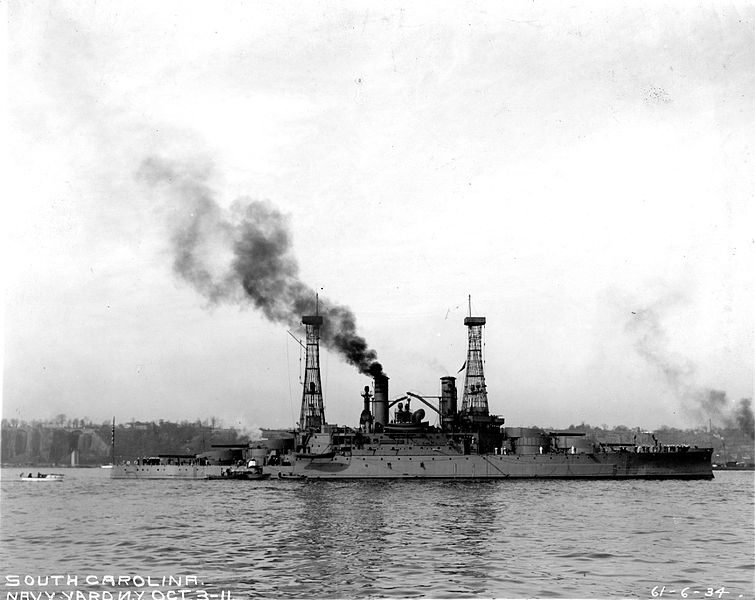
Development history
As a new breed, the BB-26 was also the 26th battleship in line with the latest design, the USS Mississippi-class. These two ships were 13,000 tonnes, but faster (17 knots), still armed with only 2×2 12 inches guns, and a mix of 8 in (203 mm), 7 in (178 mm) to deal with cruisers, and 3 in (76 mm) to deal with TBDs.
There were 116 m (382 feets) in length, 23 m (77 feets) in width. All these elements are given for comparison. These were launched in September and December 1905 and commissioned in 1908. However their design still inspired a lot the following BB-26.
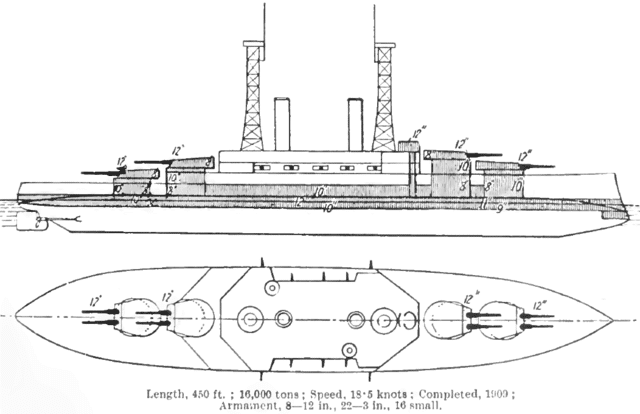
Just like their British counterparts, American naval theorists proposed that a ship mounting a homogeneous battery of large guns would be more effective in battle. This started with the Naval War College conference of 1904 that compared three Bs designs.
Prior to that already Naval Institute’s Proceedings 1902 magazine article from Lieutenant Matt H. Signor proposed a mixed 2×3 13 in (330 mm), and 2×3 10 in (254 mm) of the same 40 calibers, for a total of four triple turrets arrangement.
It was criticized by the Bureau of Construction and Repair (C&R) as unfeasible. However Homer Poundstone, USN Lieutenant Commander was the driving force between the all-big-gun design, arguing his case directly to President Theodore Roosevelt.
His design however, was a twelve 11-inch (279 mm) guns, 19,000 tons ship, (Proceedings 1903), the same year Vittorio Cuniberti’s design was out in Jane’s. His design was eventually accepted after the 1904 Newport Conference.
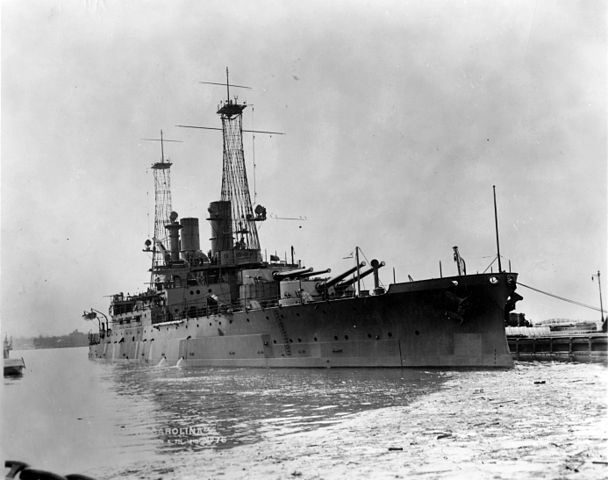
The Congress however only gave an agreement for a Connecticut class-derived design at least 2,000 long tons (2,032 t) smaller than foreign standards like the HMS Dreadnought. This obliged to take many compromises and shortcuts in design and received as expected a cold reception by most naval architects.
Eventually both were ordered almost the same day (17-18 December) at William Cramp and Sons and the New York Shipbuilding Corporation, launched in May and June 1908 and commissioned in January and March 1910 (The Michigan keel was laid down earlier, it was also commissioned earlier, the class is therefore also called “class Michigan”).
Design
The design was managed by Rear Admiral Washington L. Capps, which however did the best he could with these limitations.
One of these shortcuts was the re-use of the 12-inch (305 mm)/45 caliber Mark 5 guns already found on the Connecticut and Mississippi classes.
Although of a proven design they lacked range compared to their British equivalents. Of course the main innovation was their superfiring arrangement. Next to these, the intermediary 178-203 mm artillery has been deleted in favor of the only 3 inches rapid-fire guns to deal with destroyers and TBDs, twenty-two in all, placed in casemates. In addition here were two underwater side torpedo tubes.
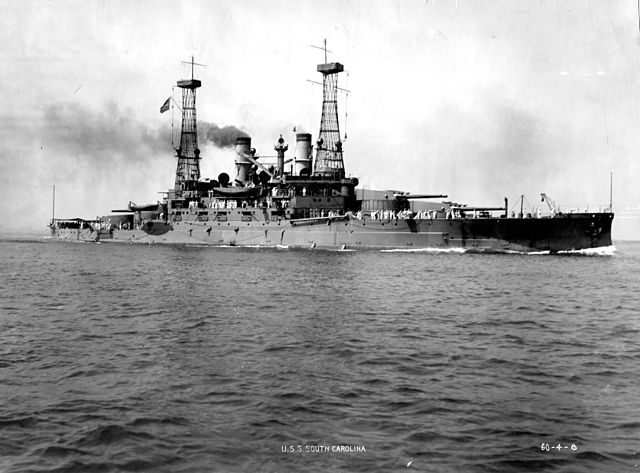
Armour scheme was described by Siegfried Breyer (a naval author) as “remarkably progressive”. However it still lacked horizontal and underwater sufficient protection. It ranged from 254 to 305 mm (10-12 in). Propulsion was covered by 229-279 mm (9-11 in), forward magazines front by 203-254 mm (8-10 in).
Casemates were 8-10 in, deck varied from 1 to 2.5 in (64 to 25 mm).Turrets and the conning tower were given of course the thickest armour at 8 to 12 inches (face/side/roof; 305–203–63.5 mm).
Barbettes were given also 8-10 in and total weight amounted to 31.4% of the design displacement. It was a bit more than the next three battleship classes which were larger and roomier.
The biggest drawback however was found in the propulsion: As limitations were drastic there was simply no room for larger engines. Therefore the same amount of power was not secured.
Although it suggested to reduced the number of boilers by 1/3, turbine propulsion was also considered and eliminated for the same reason. The Bureau of Engineering only suggested more compact boiler rooms by eliminating the centerline bulkheads.
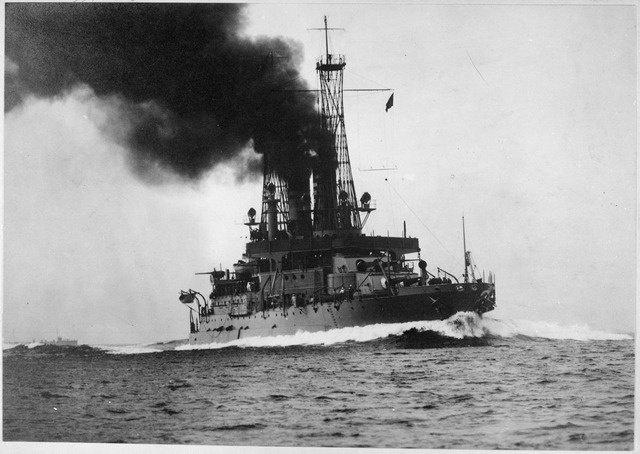
The final result was four Curtis direct-current turbogenerators (200 kW (268 hp)) coupled with twelve coal-fired superheating Babcock & Wilcox water-tube boilers (Vertical triple expansion steam engines) which produced 16,500 hp (12,304 kW) for two screws to propel the ship at 16 knots maximum. Each ship, with its slow speed and squeezed off design costed the American taxpayer $7,000,000.
Active carrer
USS Michigan
The Michigan was the first Christened at the New York Shipbuilding Corporation’s yard, by the daughter of Assistant Secretary of the Navy Truman Handy Newberry.
The event was considered of such significance that many prominent individuals were present, the governor and lieutenant-governor of Michigan, the governor of New Jersey, the mayor of Detroit, and the secretary of the Interior Department, naval admirals and constructors.
Trials of the Michigan took place at the navy’s traditional testing grounds off Rockland, Maine, from 9 June 1909, but ran aground a sandbar and needed more time for trials completion because of damaged propellers. It nevertheless made USA the third country to operate a dreadnought after UK and Germany this summer, after its august sea trials at the Delaware Capes.
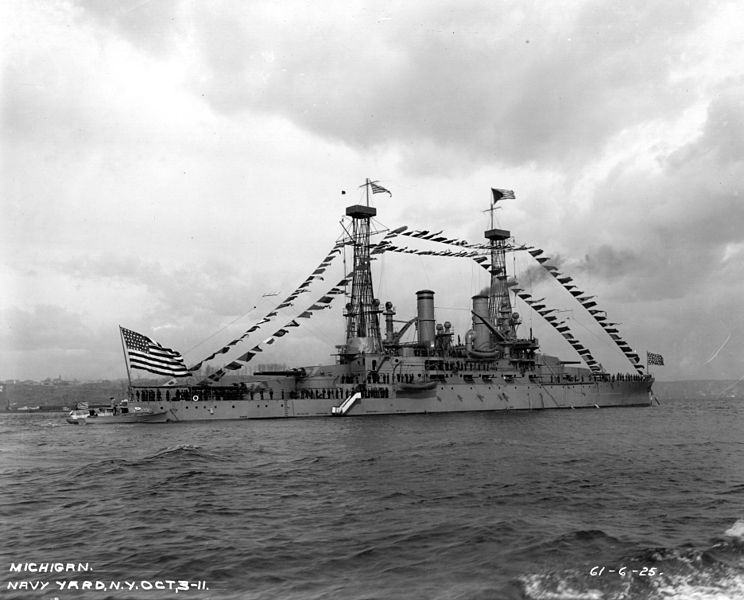
It was assigned to the Atlantic Fleet, and started a cruise down to the Caribbean Sea, and later training maneuvers off New England in the summer of 1910, following by a training cruise to Europe, sailing with her sister ship to Portland, UK, and Cherbourg, France.
Then back to the Caribbean, Guantanamo Bay, Cuba on 10 January 1911. Two days after she was back to Norfolk, and trials of the over-the-horizon naval guns triggered the need for a spotter aircraft. The next two years were followed by East coast exercises.
By November 1912, back to the Gulf of Mexico, with many stops on the way, then Veracruz, Mexico and back to Hampton Roads in December, then patrols off the east coast until the first half of 1913. In the summer she was back because of the Mexican Civil War (Tampico, 15 July, cruising until January 1914). It was then back to New York City and transferred to Norfolk.
The next month she was back to Guacanayabo Bay, Cuba, and the next month supported the United States occupation of Veracruz, landing a battalion of Marines. Then followed East coast patrols for the next three years. On 6, April 1917, with the war declaration, she was assigned to Battleship Force 2 (the reserve force) due to its slow speed. She spent time training naval recruits and escorting convoys.
On 15 January 1918, however Michigan was cruising off Cape Hatteras when she was caught into a sever gale that knocked over the forward cage mast, killing 6 and injuring another 13 men. The significance of this was not lost for future US BBs designs. Shen later trained gunners in the Chesapeake Bay, lost a screw while in escort and later in repairs until the armistice.
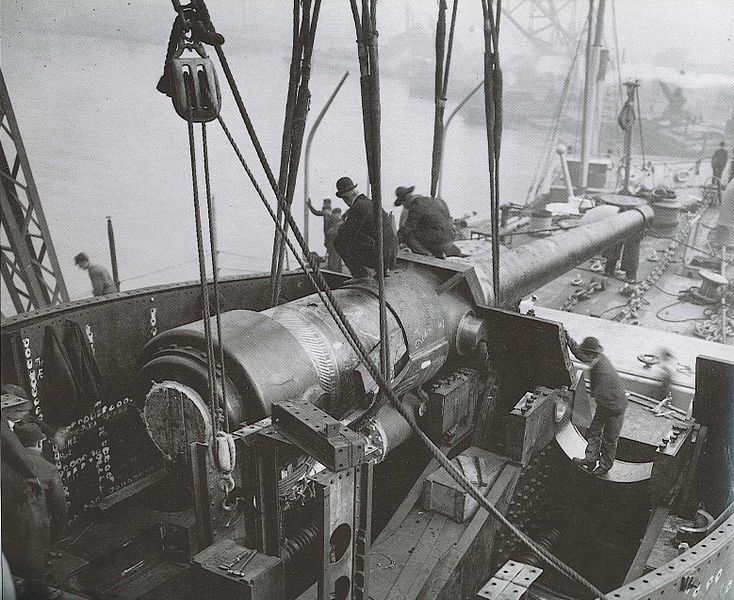
In late 1918 and 1919 USS Michigan ferried back home troops with the Cruiser and Transport Force. She was back for an overhaul from May to the end of the summer 1919 in Philadelphia.
In 1920 she was transferred to Honolulu, Hawaii, via the Panama canal. Back to Philadelphia she was decommissioned until 1921, then took part in a cruise to the Caribbean, and then was embroiled in a near-mutiny led by an officer in charge (Clark Daniel Stearns) which instituted a series of sailors’ committees to ease tensions between the crew and officers, later on judged under Marxist influence and dismissed. In May, the did another trip to Europe and in 1922 it was decided under the Washington Naval Conference to scrap it together with her sister ship.
USS South Carolina
This ship was christened by Frederica Ansel, daughter of South Carolina’s governor, and launched in July, 1st, 1908 at the William Cramp & Sons shipyard in Philadelphia.
After a reception in NY by president Theodore Roosevelt, USS South Carolina spent time training naval militia, then was down to the Danish West Indies and Cuba (April 1910) and in November took a trip to Europe with the 2nd Battleship Division, stopping at Cherbourg and Portland.
After maintenance, she was back to conduct battle training off the coast of New England. After a stop to NY, she sailed for another European tour with stops in Copenhagen, Stockholm, and Kronstadt. On the way back she was saluted by German Kaiser Wilhelm II hosting the annual Kieler Woche (Kiel Week) sailing regatta.
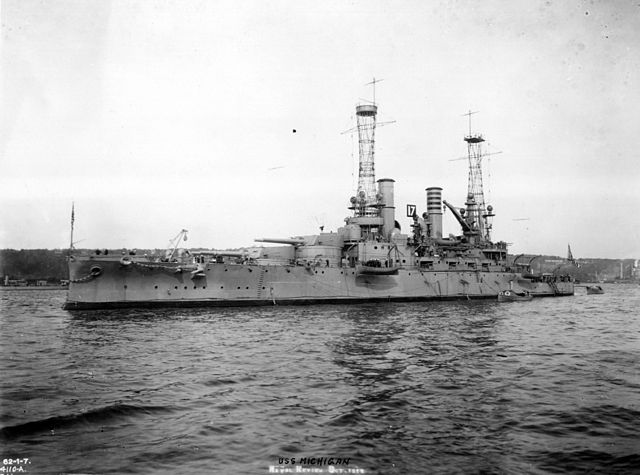
In summer she was back to Chesapeake Bay for exercises, then late 1911 was present at a naval review in New York City. In 1912 she sailed for Guantanamo Bay, Cuba, then back to Norfolk, then cruised off the east coast this summer, and was presented in a visit by the German battlecruiser SMS Moltke and light cruisers Bremen and Stettin in New York. Later in the year she was part of the Special Service Division for a tour of the Caribbean, including Veracruz.
Early 1913 she was guarding the just inaugurated Panama canal, being based at Colón. Manoeuvers at Guantanamo Bay followed, then another East coast cruise, trained US Naval Academy midshipmen and later took part in 1913 to the force sent to safeguard US interests in the Mexican civil war.
In January 1914 she was back for exercises off Culebra Island and landed a contingent of Marines ashore in Port-au-Prince, Haiti. She coaled at Key West and then sailed to Veracruz, to cover the occupation. For the next years she alternated training exercises off Cuba, maneuvers off Newport, and periodic maintenance in Philadelphia.
When the US entered war she was part of patrols from April to August 1917, then joined pre-dreadnoughts of the Atlantic Fleet began escorting convoys to France. In September 17, she lost her starboard propeller and needed repairs in Philadelphia.
Then she performed gunnery training, until Germany signed the Armistice of 11 November 1918. After that she carried over 4,000 soldiers home. In 1920 she was sent to Hawaii, then sailed back stopping in Seattle, San Francisco, and San Diego, then Philadelphia through the canal again.
She sailed to Europe in May 1921, with visits in Christiana, Norway, and Lisbon, Portugal. Decommissioned in late 1922 following the scrapping decision from the Washington Naval Conference, she was however only sold for scrap on 24 April 1924 to be dismantled. Her silver service is now on display at the South Carolina Governor’s Mansion since 1947.
Specifications
-Displacement: 16 000t, 17 617t
-Dimensions: (138m x 24,5m x 7,5m)
-Propulsion: 12 chaudières, 2 hélices, 16500 cv. et 18,5 Noeuds max.
-Armour: Belt, barbettes 250 mm, turrets, conning tower 305 mm.
-Armement: 8 x 305 mm (8 in), 22 x 76 mm (), 2 TT 533 mm sub sides.
-Crew: 870 sailors and officers
Src: The South Carolina class on Wikipedia

Rendition profile of the USS South Carolina

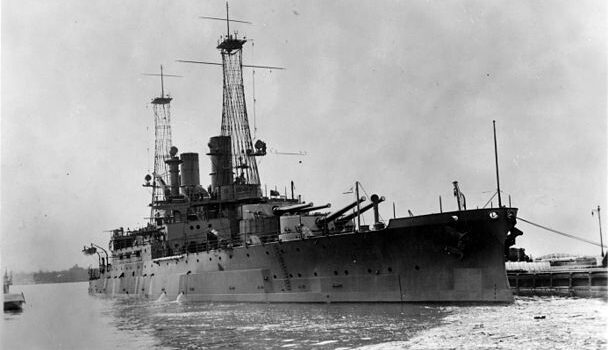
 Latest Facebook Entry -
Latest Facebook Entry -  X(Tweeter) Naval Encyclopedia's deck archive
X(Tweeter) Naval Encyclopedia's deck archive Instagram (@navalencyc)
Instagram (@navalencyc)





 French Navy
French Navy Royal Navy
Royal Navy Russian Navy
Russian Navy Armada Espanola
Armada Espanola Austrian Navy
Austrian Navy K.u.K. Kriegsmarine
K.u.K. Kriegsmarine Dansk Marine
Dansk Marine Nautiko Hellenon
Nautiko Hellenon Koninklije Marine 1870
Koninklije Marine 1870 Marinha do Brasil
Marinha do Brasil Osmanlı Donanması
Osmanlı Donanması Marina Do Peru
Marina Do Peru Marinha do Portugal
Marinha do Portugal Regia Marina 1870
Regia Marina 1870 Nihhon Kaigun 1870
Nihhon Kaigun 1870 Preußische Marine 1870
Preußische Marine 1870 Russkiy Flot 1870
Russkiy Flot 1870 Svenska marinen
Svenska marinen Søværnet
Søværnet Union Navy
Union Navy Confederate Navy
Confederate Navy Armada de Argentina
Armada de Argentina Imperial Chinese Navy
Imperial Chinese Navy Marinha do Portugal
Marinha do Portugal Mexico
Mexico Kaiserliche Marine
Kaiserliche Marine 1898 US Navy
1898 US Navy Sovietskiy Flot
Sovietskiy Flot Royal Canadian Navy
Royal Canadian Navy Royal Australian Navy
Royal Australian Navy RNZN Fleet
RNZN Fleet Chinese Navy 1937
Chinese Navy 1937 Kriegsmarine
Kriegsmarine Chilean Navy
Chilean Navy Danish Navy
Danish Navy Finnish Navy
Finnish Navy Hellenic Navy
Hellenic Navy Polish Navy
Polish Navy Romanian Navy
Romanian Navy Turkish Navy
Turkish Navy Royal Yugoslav Navy
Royal Yugoslav Navy Royal Thai Navy
Royal Thai Navy Minor Navies
Minor Navies Albania
Albania Austria
Austria Belgium
Belgium Columbia
Columbia Costa Rica
Costa Rica Cuba
Cuba Czechoslovakia
Czechoslovakia Dominican Republic
Dominican Republic Haiti
Haiti Hungary
Hungary Honduras
Honduras Estonia
Estonia Iceland
Iceland Eire
Eire Equador
Equador Iran
Iran Iraq
Iraq Latvia
Latvia Liberia
Liberia Lithuania
Lithuania Mandchukuo
Mandchukuo Morocco
Morocco Nicaragua
Nicaragua Persia
Persia San Salvador
San Salvador Sarawak
Sarawak Uruguay
Uruguay Venezuela
Venezuela Zanzibar
Zanzibar Warsaw Pact Navies
Warsaw Pact Navies Bulgaria
Bulgaria Hungary
Hungary

 Bundesmarine
Bundesmarine Dutch Navy
Dutch Navy Hellenic Navy
Hellenic Navy Marina Militare
Marina Militare Yugoslav Navy
Yugoslav Navy Chinese Navy
Chinese Navy Indian Navy
Indian Navy Indonesian Navy
Indonesian Navy JMSDF
JMSDF North Korean Navy
North Korean Navy Pakistani Navy
Pakistani Navy Philippines Navy
Philippines Navy ROKN
ROKN Rep. of Singapore Navy
Rep. of Singapore Navy Taiwanese Navy
Taiwanese Navy IDF Navy
IDF Navy Saudi Navy
Saudi Navy Royal New Zealand Navy
Royal New Zealand Navy Egyptian Navy
Egyptian Navy South African Navy
South African Navy






























 Ukrainian Navy
Ukrainian Navy dbodesign
dbodesign